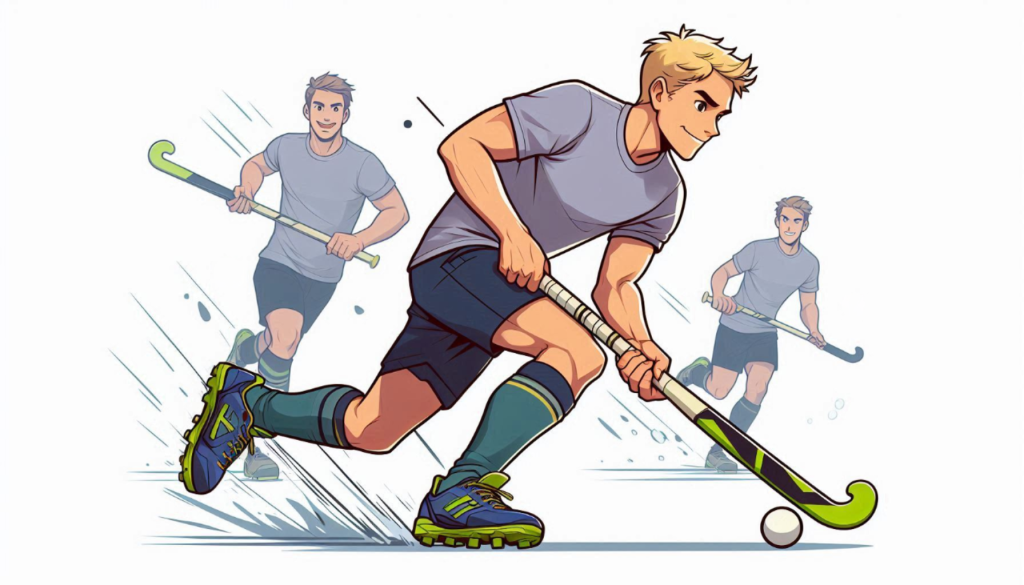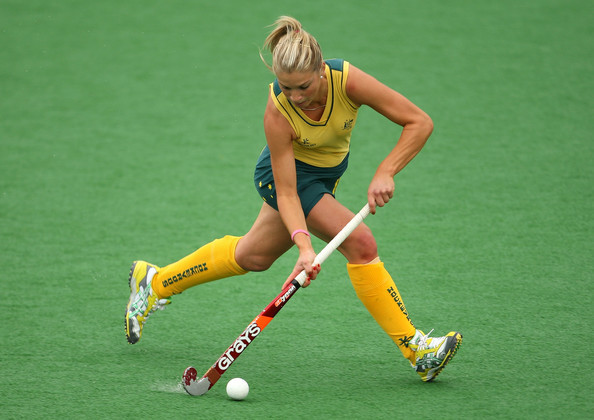Last Updated on March 15, 2025 by Andy
Field hockey has been steadily growing in popularity in the United States. The sport is primarily played at the high school and collegiate levels, with women’s field hockey being more widely recognized due to strong NCAA programs.
Many East Coast schools, especially in states like Pennsylvania, Maryland, and Massachusetts, have established competitive field hockey programs. The U.S. national teams have also made great strides in international competitions, helping to increase interest in the sport even further.
With the sport gaining more recognition in the U.S., today we’re going to talk about the basic rules of field hockey. Whether you’re a proud parent cheering from the sidelines, a student looking to pick up the sport, or just someone curious about how the game is played, this guide has you covered. We’ll dive into the history of field hockey, the essential rules, and everything you need to know to get started!
What Are the Basic Field Hockey Rules?

Field hockey or hockey is a widely played game across the globe. Introduced in the Olympic Games in 1908, a World Cup for Hockey was established in 1971. Hockey is believed to have originated in the earliest civilizations of the world. However, the modern game known as field hockey was developed in the British Isles.
Field Hockey is a game played between two teams made of 11 players. Players use sticks with curved edges to hit a small, hard ball in an attempt to score goals. These sticks measure anywhere between 28 inches and 39 inches long and weigh between 340g and 790g. The game is played on a grass pitch or an artificial surface, with artificial or astroturf pitches being common in modern hockey.
The objective of the game is similar to football: get the ball into the opponent’s goal. Players use their hockey sticks to pass, dribble, and compete for possession. The team with the most goals at the end of the match wins. If both teams score the same number of goals, the match is declared a draw.
Field Hockey Pitch
According to the International Hockey Federation (FIH), a hockey pitch is 100 yards (91.4m) long and 60 yards (55m) wide. The lengthwise end of the pitch is marked by a back line. At both ends of the pitch, touching the back line, lies the white goal post. A straight line is drawn midway between the back lines dividing the pitch into two equal halves. This distinguishing line is drawn parallel to the back line.
Key Markings on the Field:
- Penalty Spot: Marked 6.475m from the goal, this is where penalty strokes are taken.
- 25-Yard Line: Positioned 25 yards from the backline, this line helps define gameplay strategies.
- Shooting Circle (Striking Circle or “D”): A ‘D’-shaped area extending 16 yards from the goal. An attacker must be inside this area to score.
Players and Their Positions
A field hockey team consists of 11 active players on the pitch and substitutes. The team is structured with different roles:
- Goalkeeper (1 player): The last line of defense, allowed to use any part of their body to block the ball inside the shooting circle.
- Defenders: Protect the goal and stop opposing attackers.
- Midfielders: Versatile players who support both the defense and the attack.
- Attackers: Principal goal scorers, often including wings, inside forwards, and a striker.
- Sweeper: A deep-lying defender who provides additional defensive support.
The number of players in each of these positions will depend on the formation that the coach suggests for his/her individual teams.
The Game Structure
A typical hockey game consists of two halves of 35 minutes each, with half time of 5–10 minutes. A time-out can be called in case of injury. While the on field players are armed with hockey sticks, the goalkeeper dons on thick, lightweight pads as a protection for the legs with his/her stick in hand. The goalie is allowed to kick the ball or stop it with the foot or the body while in the shooting circle. Other players can handle the ball with their respective sticks only.
A coin is tossed before the game starts to decide which team starts the game. After the toss the teams regroup to their side of the pitch. Each team will be positioned in individual halves of the pitch so that they face each other. The team who won the toss game starts the game with a centre pass. The game continues until a goal is scored. When a goal is scored, the teams again regroup to their side of the pitch to begin a fresh round with a centre pass.
Essential Field Hockey Rules
- Basic Stick Handling Rules
The hard and fast rules of hockey begin with the hockey stick. Players are only allowed to hit the ball with the flat side of their stick during the game. Only the stick can be used to handle the ball, use of feet, or any other parts of the body, to control the ball during the game is strictly prohibited.
A field goal, a goal from the penalty corner or from a penalty stroke is considered as a goal. A field goal is scored from inside the striking circle by landing it in the goal guarded by the opponent’s team. If the ball is hit from outside the striking circle even if it lands in the goal, it won’t be considered as a goal. Fédération Internationale de Hockey, commonly known by the acronym FIH states that, “A goal is scored when the ball is played within the circle by an attacker and does not travel outside the circle before passing completely over the goal-line and under the cross- bar.”
Hockey is strictly a non-contact sport. Therefore, players may not trip, push, charge, interfere with, or physically handle an opponent in any way. These fouls will result in a free hit or a penalty corner for the opponent’s team. For in depth detail about the rules for outdoor/indoor check out the team USA resources.
- Fouls in Field Hockey
Players are not supposed to touch, handle or interfere with other players or their sticks or clothing. They are prohibited from playing the ball dangerously or in a way which leads to dangerous play. Players can stop, receive and deflect or play the ball in a ‘’controlled manner’’ at any height including above the shoulder unless it is dangerous or leads to danger. The game recommends that players maintain a distance of 5 metres from an opponent who is trying to receive a falling raised ball until it has been received, controlled and is on the ground.
Another rule is the third party obstruction. Sometimes, a hockey player stands in between the ball and an opponent to allow a teammate an unobstructed reach to the ball. This is also considered a punishable offence.
- Punishments For Offenses
The general ways for punishment of offenses are free hit, penalty stroke and penalty corner. Free hit is awarded by the umpire for any offenses that occurs outside of the scoring circle. A free hit is taken close to where the offence occurred. When a free hit is being executed by a player all other players should be at least 5 metres away from the ball.
The time and play are stopped after a penalty corner is awarded to a team. A penalty corner is granted when the defense either commits a foul inside the striking circle or intentionally hits the ball over the end line marking the boundary. The ball is placed on the backline at least 10 metres away from the goal post for taking the hit. Before the ball is hit by the attacking team, the players including the goalkeeper on the defending team are not supposed to move.
When an offense is committed by the defense that prevented a certain goal then a penalty stroke is awarded. Time and play are stopped for a penalty stroke as well. The ball is placed on the penalty spot and the player taking the stroke must stand behind the ball within playing distance before beginning the stroke. A goalkeeper is not permitted to move from behind the goal line before the stroke is attempted by the attacking team.
- Other Punishments
Much like Football, hockey players are also shown a card for more serious offenses. These are green, yellow and red cards. If a player breaks the rules a green card is shown as warning to forbid further offenses on the field. He /she could also be temporarily suspended for 2 minutes of playing time.
A yellow card results in a hockey player being sent off the pitch for 5 minutes. For the duration of each temporary green and yellow card suspension of a player, the offending team plays with one fewer player. Temporarily suspended players must remain in a designated place until permitted by the umpire to resume their position in the field.
When the umpire shows a red card, it indicates that the player is permanently suspended from the current match. Player should immediately leave the pitch in this case. He/she could also be suspended for a few following matches. If the player is awarded a red card, the offending team plays for the rest of the match with one fewer player.
- College Vs School Hockey Rules
There are differences between school hockey and college hockey rules. Here are some important rule differences between U.S. collegiate (NCAA) and U.S. High School field hockey.
The game duration for college hockey is 35 minutes before and after the half time while school hockey has 30 minutes of game time in each half. College hockey allows a seven minute half time while school games get a 10 minute half time. The former is permitted for one two minute timeout per team per game. The latter is granted two 90 second timeouts per team per game. School hockey players will be awarded penalty for requesting more than 2 timeouts.
It is not necessary that every offense to the set rules will be penalised. This is because interruptions to the match can be tiresome and annoying. However, all the rules set by the FIH are to be followed to avoid penalties and have a fair game.
Conclusion
Field hockey is an exciting and dynamic sport that continues to grow in popularity, especially in the United States. By understanding the essential rules, player positions, and game structure, anyone can start enjoying and appreciating the game. Whether you’re a player, coach, or fan, mastering these basics will enhance your experience on the field.





